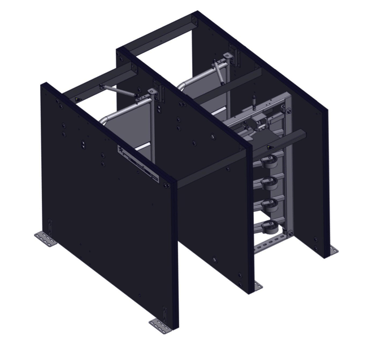
How you design your hog penning and gating in a gilt developer unit (GDU) and the ESF training pen is key to making your gilts comfortable with the new environment of a group sow housing facility. As your gilts develop, we have to incorporate ways to naturally acclimate them and make them comfortable with what they will see and interact with in the ESF pens. Training the gilts to be comfortable with human interaction is essential when they are young, but as the girls mature, we should start introducing them to the equipment and processes they will see later on in a group gestation pen. This will make the transition to group sow housing much smoother for both the pigs and your barn staff.
When we set up for pre-training and training, we strategically design the hog penning and gating to let the gilts become comfortable with the equipment on their own. There are actually three pens styles we use during development and training if you include the ESF training pen and each one is specific to age and size.
Designing Your Hog Penning and Gating
For younger pigs (50 – 150 pounds) we design pens with a divider wall to create an area on one side of the wall that is about 60% of the total space, leaving 40% on the other side. On the smaller side, we place the watering area for the pigs while we place the feeders on the larger side. In the divider wall, there are one way gates taken from auto sorting systems used primarily in finishing houses.

The divider wall also will have at least one regular gate in it that is left open initially so that pigs can always access feed and water. Through natural curiosity, the gilts will learn to go through the one-way gates on their own, removing any hesitation from entering something enclosed. Once the gilts have become comfortable with the pen layout, the regular gate will be closed so they have to pass through the one-way gates on a regular basis to access both feed and water.
Once the gilts grow to a size that is big enough to be able to use a graduated method of one-way gates, we’ll move them to a pen with more available space that has “pre-training” gates in place of the one way gates. This pre-training gate assembly will use the same gates that are in the Nedap ESF feed stations we design into group gestation pens in our group sow housing facilities. Again, through natural curiosity, the girls will learn to open and pass through these gates on their own and without fear.

There is also the option of designing a pen that has both one-way gate styles incorporated. We would achieve the extra square footage needed for the larger and growing gilts by selecting out the ones who won’t be kept. A pen that is stocked at 7.5 square feet per animal when the girls are younger will be able to attain 12 + square feet with a 60 - 70% selection rate. The 30 - 40% of gilts that are culled will be moved out to market, creating the needed space. With this pen design, a gate would be used to open or close either of the one-way gate styles so the pigs use only the size appropriate gates.
How to Train Your Gilts
Training your gilts' patterns and habits can be a frustrating process if handled improperly, but it is much easier for everyone involved (including the pig) if you let the girls learn the new processes on their own. Pigs are naturally curious and social animals; understanding this helps make the training process much less of a hassle. We previously published a blog on the 4 Rules to Remember When Preparing Gilts for an ESF Barn, which explains exactly how we approach the training of our young pigs. We believe that if you let the pigs lead the way, earn their trust, and train them with positive reinforcement, the transition to group gestation pens will be much easier.
If you have an questions on how to train your gilts for a group sow housing facility or our hog penning and gating products, please reach out to us or setup a free consultation by clicking the button below.





